Methods of Crack Repair in Concrete (2)
Following the evaluation of the cracked structure, a suitable repair procedure can be selected. Successful repair procedures take into account the cause(s) of the cracking. For example, if the cracking was primarily due to drying shrinkage, then it is likely that after a period of time the cracks will stabilize. On the other hand, if the cracks are due to a continuing foundation settlement, repair will be of no use until the settlement problem is corrected. In this series of articles under the title of “Methods of Crack Repair in Concrete“, the different techniques applied to repair cracks are discussed. This article includes Routing and Sealing, Stitching and Additional Reinforcement.
⇒ Routing and Sealing
Routing and sealing of cracks can be used in conditions requiring remedial repair and where structural repair is not necessary. This method involves enlarging the crack along its exposed face and filling and sealing it with a suitable joint sealant (Figure 1). This is a common technique for crack treatment and is relatively simple in comparison to the procedures and the training required for epoxy injection. The procedure is most applicable to approximately flat horizontal surfaces such as floors and pavements. However, routing and sealing can be accomplished on vertical surfaces (with a non-sag sealant) as well as on curved surfaces (pipes, piles and pole).
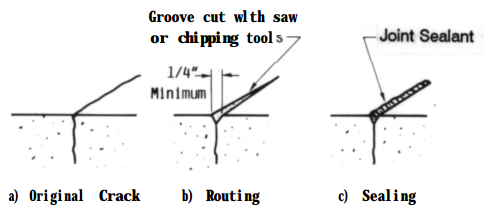
Routing and sealing is used to treat both fiie pattern cracks and larger, isolated cracks. A common and effective use is for waterproofing by sealing cracks on the concrete surface where water stands, or where hydrostatic pressure is applied. This treatment reduces the ability of moisture to reach the reinforcing steel or pass through the concrete, causing surface stains or other problems.
The sealants may be any of several materials, including epoxies, urethanes, silicones, polysulfides, asphaltic materials, or polymer mortars. Cement grouts should be avoided due to the likelihood of cracking. For floors, the sealant should be sufficiently rigid to support the anticipated traffic. Satisfactory sealants should be able to withstand cyclic deformations and should not be brittle.
The procedure consists of preparing a groove at the surface ranging in depth, typically, from 6 to 25 mm. A concrete saw, hand tools or pneumatic tools may be used. The groove is then cleaned by air blasting, sandblasting, or waterblasting, and dried. A sealant is placed into the dry groove and allowed to cure.
A bond breaker may be provided at the bottom of the groove to allow the sealant to change shape, without a concentration of stress on the bottom (Figure 2). The bond breaker may be a polyethylene strip or tape which
will not bond to the sealant.
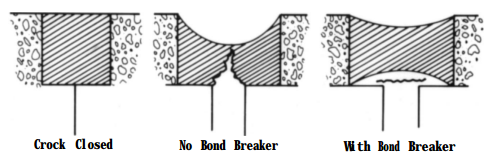
Careful attention should be applied when detailing the joint so that its width to depth aspect ratio will accommodate anticipated movement.
In some cases overbanding (strip coating) is used independently of or in conjunction with routing and sealing. This method is used to enhance protection from edge spalling and for aesthetic reasons to create a more uniform appearing treatment. A typical procedure for overbanding is to prepare an area approximately 25 to 75 mm on each side of the crack by sandblasting or other means of surface preparation, and apply a coating (such as urethane) 1 to 2 mm thick in a band over the crack. Before overbanding in non-traffic areas a bond breaker is sometimes used over a crack that has not been routed, or over a crack previously routed and sealed. In traffic areas a bond breaker is not recommended. Cracks subject to minimal movement may be overbanded, but if significant movement can take place, routing and sealing must be used in conjunction with overbanding to ensure a waterproof repair.
⇒ Stitching
Stitching involves drilling holes on both sides of the crack and grouting in U-shaped metal units with short legs (staples or stitching dogs) that span the crack as shown in Figure 3. Stitching may be used when tensile strength must be reestablished across major cracks. Stitching a crack tends to stiffen the structure, and the stiffening may increase the overall structural restraint, causing the concrete to crack elsewhere. Therefore, it may be necessary to strengthen the adjacent section or sections using technically corrected reinforcing methods. Because stresses are often concentrated, using this method in conjunction with other methods may be necessary.
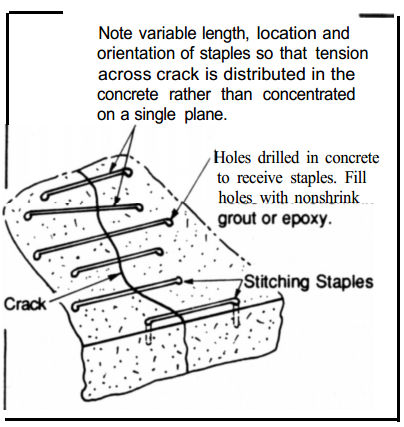
The stitching procedure consists of drilling holes on both sides of the crack, cleaning the holes, and anchoring the legs of the staples in the holes, with either a nonshrink grout or an epoxy resin-based bonding system. The staples should be variable in length, orientation, or both, and they should be located so that the tension transmitted across the crack is not applied to a single plane within the section but is spread over an area.
⇒ Additional Reinforcement
Conventional Reinforcement
Cracked reinforced concrete bridge girders have been successfully repaired by inserting reinforcing bars and bonding them in place with epoxy.
This technique consists of sealing the crack, drilling holes that intersect the crack plane at approximately 90 deg (Figure 4), filling the hole and crack with injected epoxy and placing a reinforcing bar into the drilled hole. Typically 10 M or 15 M bars are used, extending at least 0.5 m each side of the crack. The reinforcing bars can be spaced to suit the needs of the repair. They can be placed in any desired pattern, depending on the design criteria and the location of the in-place reinforcement. The epoxy bonds the bar to the walls of the hole, fills the crack plane, bonds the cracked concrete surfaces back together in one monolithic form, and thus reinforces the section. The epoxy used to rebond the crack should have a very low viscosity and conform to ASTM C 881 Type IV.
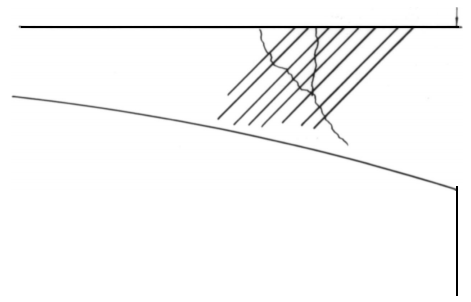
Prestressing steel
Post-tensioning is often the desirable solution when a major portion of a member must be strengthened or when the cracks that have formed must be closed (Figure 5). This technique uses prestressing strands or bars to apply a compressive force. Adequate anchorage must be provided for the prestressing steel, and care is needed so that the problem will not merely migrate to another part of the structure. The effects of the tensioning force (including eccentricity) on the stress within the structure should be carefully analyzed. For indeterminate structures post-tensioned using this procedure, the effects of secondary moments and
induced reactions should be considered.
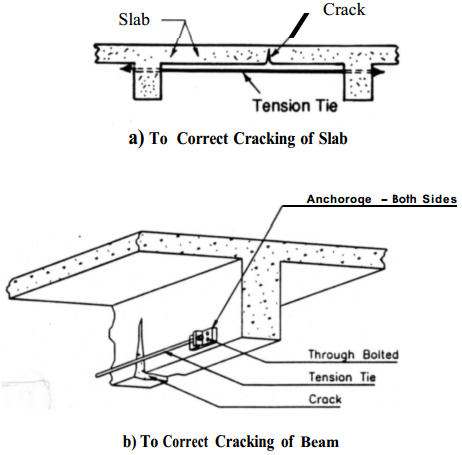
Source: ACI 224.1R-93: Causes, Evaluation and Repair of Cracks in Concrete Structures
